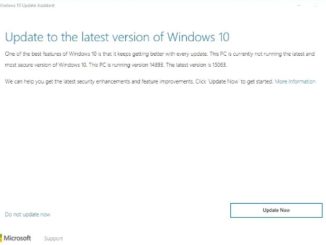Often times it happens that files on Windows 10 PC get corrupted and stop working properly. Malfunctions and unexpected errors had been a constant feature on Microsoft Windows OS in the past, although, things have improved considerably in latest Windows 10. But still its good to be on the safer side and know how to recover important data files in case of errors or virus attacks. In new Windows OS versions like Windows 8, Windows 8.1 and Windows 10 a new backup featured namely File History has been added that backs up files automatically. Now you can restore older functioning version of files at any time if you feel existing one is failing to load properly.
Unlike in Windows 8 and Windows 8.1 for some strange reason File History option isn’t enabled by default. You will have to turn it on manually on Windows 10 as we will show you down below in this post. With File History feature you can backup important files on secondary drive, using external drive is recommended. Although File History provides a safer option to save data automatically on the system, but it’s better to save files on some external storage device as well. If Windows 10 copy is faulty and doesn’t load prompting fresh install, all your files backed up in File History will be lost with it, so keep another option at hand.
Windows 10 File History Feature:
First of all, you must enable File History feature manually by going to the settings menu as it is turned off by default. See instructions below for it.
- Go to Start > Settings > Update & Security and select Backup option from the list on the left side of the window.
- You will be Back up using File History option on the right side of the window with Add Drive option under it.
- Click on Add Drive, Windows will scan all available drives on the system and show them in the list. If an external drive is connected it will also appear in the list.
- Select the drive on which you want to back up files.
A new File History folder will be created automatically on the drive where all files will be backed up in the future. It is also important that you see Backup Options before proceeding by clicking on More Option just below Add Drive. In Backup Options you can set how often and when you want File History to backup files on the selected drive. You set backup option to every hour, days or month. Choose for how long to keep the backup in the File History, this option is useful in case you think drive is running out of space. Also select what files from within each folder you want to backup. Often there are many unnecessary files, so backing up entire folder saves unimportant files as well, which consumes space on the drive.
You can choose to backup Videos, Audio, Pictures, Camera Roll folder, Documents, Workspace, OneDrive, Desktop, Games, links and other files & folders in user account folder.
Recover Files Manually:
Here is how you can restore files saved in the File History folder.
- Go to File Explorer
- Right-click on the file you want to recover and choose Restore previous versions from context menu.
- Head to Previous Versions in the Properties window.
- You will see two options Open the previous version in file history and Restore the file to the location you want outside File History folder.
Also See: How to Reset Windows 10 & How To Recover Deleted OneDrive files



